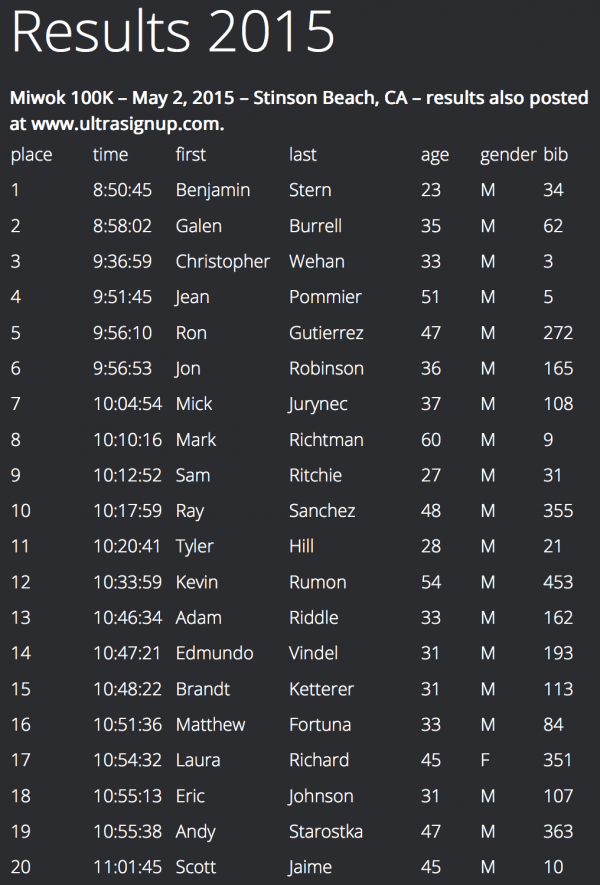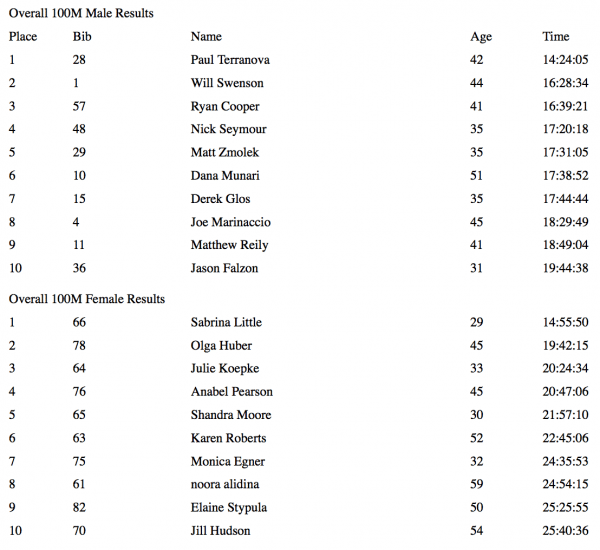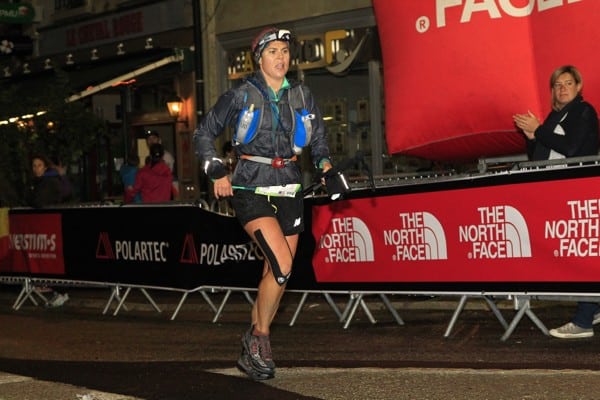From Pam:
When we talk about events, we always mention them as a singular entity: the Western States 100 Mile, the Miwok 100k, the American River 50 Mile. But conceptually, I think we all realize they are actually two races–a men’s race and a women’s race–and at the end of these events we recognize two champions. Yet many of the race results in ultrarunning are listed with the men and women combined.

2015 Miwok 100k results. Image is a screenshot from the race’s website.
I think the combined results highlight women’s achievements when women place well in the field overall (like Rory Bosio making the top-10 overall at UTMB), but women’s results can become obscured when there is a really deep field, such as at Western States, where one would have to scroll down to 20th place to find Magda Boulet’s winning time from this year and it is nearly impossible to pick out the top-10 women unless you count them out yourself. In these instances, it feels a lot like the women’s results are buried amongst the men’s.
What do you think, ladies? Is there a better way to highlight the women’s results or do you think things are fine just the way they are?
From Liza:
I don’t know, I’ve always kind of liked the way finishers are all mixed together. I remember getting my first copy of UltraRunning Magazine and searching for my name in the list of Rocky Raccoon 100 Mile finishers. I liked seeing my overall placement. I thought the mass listing highlighted the decreased gender disparity in finishing times in our sport. And I took it as a subtly affirming message. “Hey, we’re all just crazy people running 50 and 100 miles. Male, female… if you’re a wingnut willing to run for a belt buckle, you’re on equal footing with the rest of us.”
Jennifer Pharr Davis wrote a wonderful article for The New York Times last year examining the equalizing force of distance on performance. My favorite quote from the piece is from Heather Anderson, who holds overall (for both genders) self-supported speed records on the Pacific Crest and Appalachian Trails. She says, “I believe that endurance is most likely genderless.”
Still, at least up to the 100-mile distance, the fastest men are faster than the fastest women. I guess I’m just ambivalent about whether results should emphasize men’s and women’s racing over individual performance. That speaks more to the fact that I don’t like racing than an unwillingness to champion women’s sport, though. Certainly, it seems simple enough to list the top-10 male and top-10 female performances before the overall results. That’s what race administrators Tejas Trails do for Rocky Raccoon now.

2016 Rocky Raccoon 100 Mile results. Image is a screenshot from the race’s website.
It makes it much easier to follow women’s racing. And there’s no reason ultrarunning nerds shouldn’t be able to rattle off top female runners like they can male runners. And maybe highlighting women’s performances would encourage some women to race harder–and inspire others to set higher goals for themselves. Even a just-in-it-for-the-belt-buckle-and-tall-tales runner like me would support separating male and female race results if that was the case.
From Gina:
Pam, I know exactly what you’re talking about! I hate having to scroll through lists to count positions! Some results aren’t numbered separately for men and women. Thus, the first-place woman might actually be counted officially as 25th place, for example.
I’m not really sure why most race organizers list results this way. I can let my bold and outspoken ideals point at laziness and ignorance, but I doubt those are the reasons. My guess is that when the whole sport of racing began, there were obviously no/very few women, thus, race organizers wouldn’t have the need for two listings. Thus, the listing style has never changed, even though there are many more women racing, including in some distances/events more women than men.
Personally, I’d appreciate having my gender grouping displayed in an organized fashion. Or, have one master list, and then a separate men’s list and women’s list. When viewing results, it is much easier and more meaningful to me to see where I stand amongst my female friends/competitors. With all the women’s info collated in one list, I am able to see the difference in splits, times, and more, which is super helpful and insightful for future training and racing.
To take things a step further, or to at least bring up the topic, what about race logistics and their effects on male and female finishes? Does hosting a women’s race at the same time as a men’s race change people’s interest in and support of the women’s race?
Let’s take the example of UTMB. The top male finishers always arrive to the finish line in the daylight of a Saturday afternoon in Chamonix, France. Chamonix’s streets are packed with several-thousand people cheering for those top men. The route, which traces for about a kilometer through the town’s streets and to the finish chute, is lined with people, and the finish line is jam packed eight or 10 people deep for its 150-ish-meter length. The presence and cheering of those several thousand people make it perhaps the most powerful and exciting finish line that exists for a trail/mountain race.
Hours and many male finishers later, the top female arrives. She typically finishes in the early evening hours on Saturday, what is still prime-time hours for a European tourist town. She is typically greeted by perhaps a couple-thousand people throughout Chamonix’s streets–impressive by almost any standard we have in trail racing–but still many fewer people than for the top man. By the time the third-place women arrives, she is lucky to be greeted by a couple hundred people.
I ran the Chamonix, Courmayeur, Champex (CCC) event, a UTMB sister race, in 2014 as my first 100k. I was scared to death of the race. It was an uncharted distance and me being the all-or-nothing person that I am, I chose one of the toughest 100ks in the world. At the time, it was the hardest race I’d ever run. My goals were top five, top U.S. female finisher, and to run under 16 hours so that I could qualify for the Western States lottery.
I arrived at the finish line around 1 a.m. and as top U.S. female in fifth in 15:59:13 seconds. I was on cloud nine, and so hoped to share this proud finish with cheers and clapping. Instead, I received a few welcome claps from seven to 10 people and a hug from a friend who happened to be following the race progress. (Thank you, Greg Houston!)

Gina Lucrezi taking fifth at the 2014 CCC. Photo courtesy of Gina Lucrezi.
I was never so happy and so bummed at the same time. I didn’t expect the same finisher’s parade as the top male or female, but I was hoping for some exciting energy as I ran through the winding streets of Chamonix and into the finishers’ arch. When you work that hard, you really hope there are people at the end to share that moment with you.
From Liza:
What do you readers think? Should male and female top-10 performances be listed before overall results? Should race results be listed separately by gender? How would that affect you? Would you want ultramarathons to stagger their starts by gender like some marathons to ensure celebration and hoopla equality at the finish line? Are there other ways that hosting a women’s trail race contemporaneously to a men’s race changes the women’s race?
Call for Comments (from Meghan)
What do you think of the questions Liza poses? Share your thoughts in the comments section.
